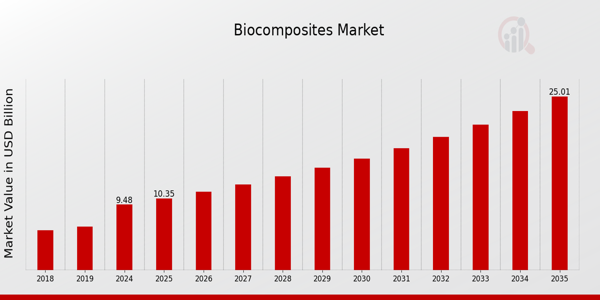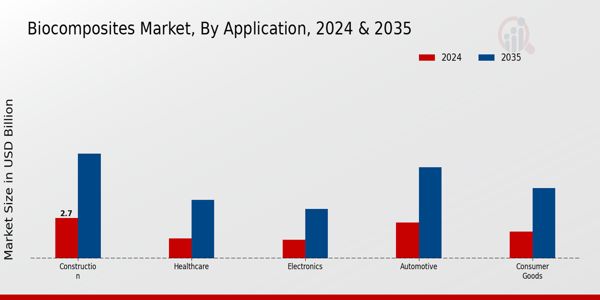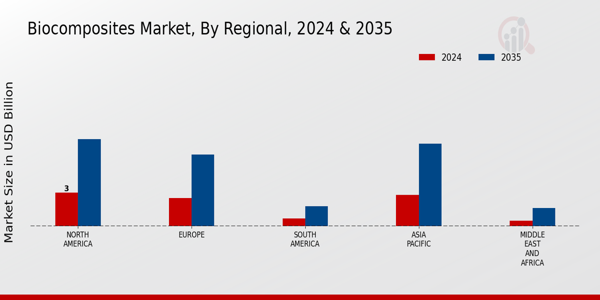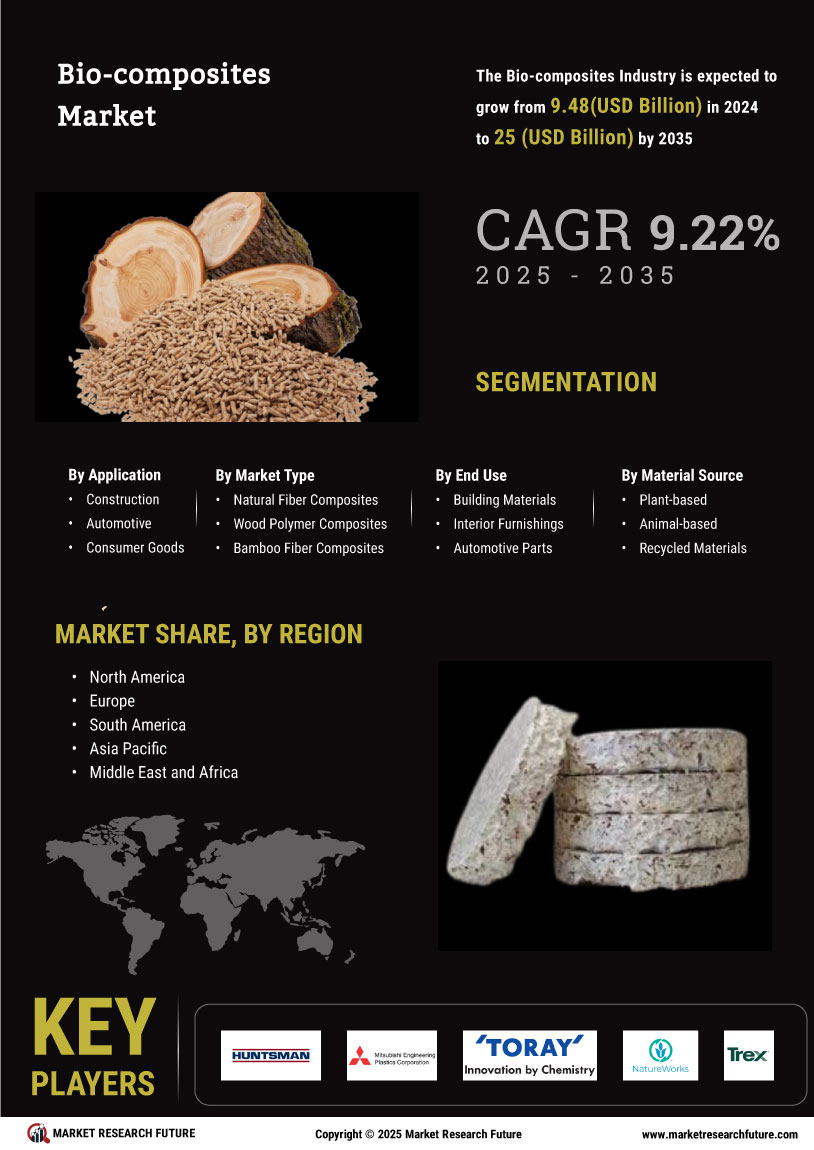Biocomposite Market Summary
As per Market Research Future Analysis, the Global Biocomposites Market was valued at 8.68 USD Billion in 2023 and is projected to grow to 25 USD Billion by 2035, reflecting a CAGR of 9.22% from 2025 to 2035. The market is driven by increasing demand for sustainable materials, technological innovations, and heightened awareness of environmental issues.
Key Market Trends & Highlights
The Biocomposites Market is witnessing transformative growth influenced by sustainability and technological advancements.
- Market size in 2024: 9.48 USD Billion; projected to reach 25 USD Billion by 2035.
- Construction sector valued at 2.1 USD Billion in 2024; expected to grow to 5.5 USD Billion by 2035.
- Automotive sector projected to expand from 2.2 USD Billion in 2024 to 6.0 USD Billion by 2035.
- Consumer Goods market expected to rise from 2.3 USD Billion in 2024 to 6.5 USD Billion by 2035.
Market Size & Forecast
2023 Market Size: USD 8.68 Billion
2024 Market Size: USD 9.48 Billion
2035 Market Size: USD 25 Billion
CAGR (2025-2035): 9.22%
Largest Regional Market Share in 2024: North America.
Major Players
Key players include Trex Company, Trestle Holdings, Stora Enso, Cargill, Green Fiber, FlexForm Technologies, Bioworks, Mitsubishi Chemical, Sappi, Natureworks, BASF, Hexcel, Metsa Group, Dow, and DuPont.
Key Biocomposites Market Trends Highlighted
The Biocomposites Market is experiencing significant growth due to several key market drivers. The increasing focus on sustainability and environmental protection is driving demand for biocomposites, as consumers and industries seek eco-friendly alternatives to traditional materials. Government initiatives promoting the use of renewable resources and reducing carbon footprints further support this trend. As corporations push for greener manufacturing processes, there is a growing preference for biocomposites in sectors such as automotive, packaging, and construction.
Another vital aspect is the continuous advancements in biocomposite technologies that enhance material properties and expand their application areas.One area to look into is the aerospace industry, where biocomposites could be useful because lightweight, strong materials are needed to make planes more fuel-efficient. Also, as more people learn about eco-friendly products, biocomposites can be improved, especially in electronics and consumer goods. The market can benefit from partnerships between research institutions and manufacturers to make new bio-based materials. In recent years, there has been a rise in research and development efforts aimed at making biocomposites work better and cost less.
As circular economy models become more popular, industries are changing the way they get materials and deal with waste. This is a good fit for biocomposites.
Moreover, market players are increasingly emphasizing the integration of biodegradable components to cater to diverse consumer needs. Overall, the Biocomposites Market is on a transformative path driven by environmental, technological, and consumer factors.

Source: Primary Research, Secondary Research, Market Research Future Database, and Analyst Review
Biocomposites Market Drivers
Rising Demand for Sustainable Materials
The Biocomposites Market is experiencing significant growth due to rising consumer demand for sustainable and eco-friendly materials. According to a report by the European Bioplastics association, the production capacity of bioplastics is expected to double by 2026, indicating a robust demand trend. Several nations are implementing stricter regulations on carbon emissions and plastic usage, driving manufacturers to explore biocomposite materials as viable alternatives.Organizations such as the United Nations Environment Programme advocate for the use of sustainable materials, further backing this trend.
Additionally, the push towards achieving sustainable development goals has caused manufacturers to invest in Research and Development for biocomposites, which in turn is expected to bolster the growth of the Biocomposites Market significantly.
Technological Innovations in Material Processing
Advancements in material processing technology have emerged as a significant driver for the Biocomposites Market. Innovations such as enhanced fiber treatment methods and new binding technologies are improving the performance properties of biocomposites, making them more appealing for a wider range of applications. For instance, the adoption of patented composite manufacturing processes has been shown to enhance the durability and mechanical properties of bio-based materials by 30%, as per data collected from industrial partnerships.
Leading organizations in the manufacturing sector are increasingly collaborating to improve the efficiency of biocomposite production, effectively driving market expansion.
Growing Awareness of Environmental Issues
Increased awareness regarding environmental issues and the reduction of plastic waste are driving factors for the Biocomposites Market. Reports from the World Economic Forum indicate that around 300 million tons of plastic are produced each year, and much of this ends up in oceans, prompting a shift towards biocomposites. Governments ly are recognizing this challenge and actively promoting the use of biocomposites as a viable solution to plastic pollution.For example, countries like Canada and Germany are leading initiatives to reduce single-use plastics by implementing regulations that encourage the adoption of biocomposite materials.
The rising public consciousness around sustainability is likely to sustain future growth in this market.
Biocomposites Market Segment Insights
Biocomposites Market Application Insights
The Biocomposites Market, particularly within the Application segment, has witnessed substantial growth, reflecting the increasing demand for sustainable and environmentally friendly materials across various industries. By 2024, the market is valued at 9.48 USD billion, with the projected growth prominently illustrated in the specific applications such as Construction, Automotive, Consumer Goods, Electronics, and Healthcare, highlighting their importance in the overall biocomposite landscape.
The Construction sector is among the largest, valued at 2.1 USD Billion in 2024 and expected to reach 5.5 USD billion by 2035, indicating a significant increase as the industry seeks more sustainable building materials to reduce environmental impact.This trend towards adoption in construction is driven by government regulations and a growing emphasis on green building practices, making it a major player in the Biocomposites Market revenue. Similarly, the Automotive sector, valued at 2.2 USD Billion in 2024, is projected to expand to 6.0 USD Billion by 2035.
The significance of biocomposites in automotive applications is seen in their potential to improve fuel efficiency and reduce vehicle weight, further aiding in the reduction of carbon emissions, which is crucial in the current climate-conscious market.Consumer Goods represent another vital area, with a market valuation of 2.3 USD Billion in 2024, expected to elevate to 6.5 USD billion by 2035. The shift towards biocomposites in everyday products is driven by consumer preference for sustainable options, making this application significantly relevant.
Electronics, with a valuation of 1.4 USD Billion in 2024 projected to reach 4.0 USD billion by 2035, has found niche applications, emphasizing the development of biodegradable components, which are essential for reducing e-waste.
Lastly, the Healthcare sector, while smaller, valued at 1.48 USD Billion in 2024 and expected to grow to 3.0 USD Billion, showcases the applicability of biocomposites in medical devices, scaffolding, and drug delivery systems, underscoring the importance of biocomposite materials in enhancing patient outcomes while being environmentally friendly.Overall, the segmentation of the Biocomposites Market demonstrates a strong alignment with sustainability goals, providing numerous opportunities for growth and innovation across these pivotal applications. The increasing focus on using renewable and sustainable materials in these sectors showcases the market's potential for robust expansion while addressing contemporary environmental challenges.

Source: Primary Research, Secondary Research, Market Research Future Database, and Analyst Review
Biocomposites Market Type Insights
The Biocomposites Market is witnessing notable growth driven by the diverse types of biocomposites available. Among these, Natural Fiber Composites, Wood Polymer Composites, Bamboo Fiber Composites, and Hemp Fiber Composites play crucial roles in various applications. The overall market is expected to achieve a valuation of 9.48 USD billion by 2024, reflecting the rising demand for sustainable and eco-friendly materials across industries.
Natural Fiber Composites, which utilize plant-based materials, contribute significantly to the market's revenue due to their lightweight and high strength-to-weight ratios.Wood Polymer Composites are increasingly favored in construction and automotive sectors for their durability and resistance to moisture compared to traditional materials. Meanwhile, Bamboo Fiber Composites are gaining traction due to the fast growth rate of bamboo, making them an attractive renewable resource. Hemp Fiber Composites offer benefits such as carbon sequestration and lower energy consumption during production, appealing to environmentally conscious consumers.
This variety in types not only enhances the Biocomposites Market segmentation but also presents numerous growth opportunities while addressing challenges such as supply chain limitations and processing costs.These factors are expected to drive the market further, aligning with the increasing emphasis on sustainable practices ly.
Biocomposites Market End Use Insights
The Biocomposites Market is experiencing substantial growth, particularly in the End Use segment, which encompasses various applications such as Building Materials, Interior Furnishings, Automotive Parts, and Packaging Materials. By 2024, the overall market is expected to be valued at 9.48 billion USD, showcasing the demand for sustainable alternatives in multiple industries. Among these applications, Building Materials and Automotive Parts are significant as they align with trends towards sustainability and ecological responsibility.The rising emphasis on reducing carbon footprints has led to increased adoption of biocomposite materials in the construction and automotive sectors.
Interior Furnishings is also a critical area, as consumers seek eco-friendly products that combine aesthetics with sustainability. Additionally, the growing eco-conscious trend is transforming Packaging Materials, driving demand for biodegradable and renewable components in consumer goods. The Biocomposites Market data indicates a shift towards sustainable solutions, revealing opportunities for innovation and expansion as industries pivot towards greener materials, thus influencing market growth profoundly.The market is well-positioned to capitalize on these trends and challenges, fostering resilience and adaptability across the spectrum of applications.
Biocomposites Market Material Source Insights
The Biocomposites Market, particularly in the context of Material Source, is experiencing notable transformations driven by sustainable practices and eco-friendly materials. By 2024, the market is projected to reach a value of 9.48 USD billion, emphasizing the growing adoption of biocomposites across various industries. Within this segment, Plant-based materials are gaining momentum due to their renewable nature and lower environmental impact, serving as a significant driving factor for market growth.
Recycled materials are also prominently featured, as they address waste reduction and promote sustainability.Meanwhile, Animal-based resources play a crucial role in providing unique properties that enhance product performance, though they comprise a smaller portion of the overall usage. As companies increasingly prioritize sustainable solutions, the Biocomposites Market segmentation reflects a clear trend towards responsible sourcing practices, which are essential for meeting both consumer demand and regulatory requirements ly. These trends underscore the need for continuous innovation and investment in Research and Development to harness the full potential of these material sources and capture market opportunities in the future.
Biocomposites Market Regional Insights
The Biocomposites Market exhibits considerable regional segmentation, with North America leading the market valuation at 3.0 USD Billion in 2024 and projected to reach 7.8 USD Billion by 2035. This region demonstrates a major trend towards sustainability in manufacturing, playing a vital role in market growth. Europe follows closely with a valuation of 2.5 USD Billion in 2024, expected to grow to 6.4 USD Billion, as stringent environmental regulations drive demand for eco-friendly materials.
The Asia Pacific region, valued at 2.8 USD Billion in 2024, is anticipated to expand rapidly, reaching 7.4 USD billion, fueled by increased industrialization and consumer awareness of sustainable products.South America, while smaller in comparison with 0.7 USD Billion in 2024, is projected to grow to 1.8 USD Billion, showing potential due to its rich natural resources and emerging markets. Lastly, the Middle East and Africa are valued at 0.48 USD billion and expected to reach 1.6 USD billion, reflecting growing investment in renewable materials in these regions.
Each region presents unique opportunities and challenges, with local policies and market dynamics heavily influencing their respective positions within the Biocomposites Market.

Source: Primary Research, Secondary Research, Market Research Future Database, and Analyst Review
Biocomposites Market Key Players and Competitive Insights
The Biocomposites Market is increasingly gaining traction as companies and consumers seek environmentally friendly alternatives to traditional materials. This market encompasses a wide array of products made from renewable resources that offer enhanced properties such as improved durability, lightweight characteristics, and reduced environmental impacts. Emerging technologies and evolving consumer preferences are driving significant innovations in biocomposite materials, leading to heightened competition among key players in the sector. The competitive landscape is characterized by various strategies, with companies vying for market share through advancements in product development, strategic partnerships, and sustainability initiatives.
As the demand for sustainable materials intensifies ly, companies are also focusing on expanding their reach and strengthening their brand presence to cater to diverse industries such as automotive, construction, and consumer goods.Trex Company stands as a prominent player in the Biocomposites Market, primarily known for manufacturing high-performance wood-alternative decking products that are environmentally responsible. The company leverages its unique formulation of recycled materials, offering products that are resistant to fading, staining, and mold, which are increasingly favored by consumers looking for low-maintenance and eco-friendly solutions.
With a strong focus on sustainability, Trex Company has built a robust brand reputation, allowing it to maintain a competitive edge in the market. By continually investing in research and development, Trex is able to innovate and expand its product lines, showcasing its strengths in quality and consumer satisfaction. The company’s commitment to eco-conscious manufacturing processes further strengthens its position in a rapidly evolving market.Trestle Holdings has established its presence in the Biocomposites Market through a diversified portfolio that includes innovative biocomposite materials designed for various applications.
The company emphasizes the development of products that combine both functionality and sustainability, catering to sectors including construction and packaging. Trestle Holdings is recognized for its strong market presence and commitment to eco-friendly practices, thus appealing to a broad customer base. Its strengths lie in the ability to customize solutions based on market needs, which has been supported by strategic mergers and acquisitions aimed at enhancing capabilities and expanding its product offerings. The company is actively pursuing opportunities to strengthen its supply chain and enhance operational efficiencies, ensuring it remains competitive in this booming industry.
Key Companies in the Biocomposites Market Include
- Trex Company
- Trestle Holdings
- Stora Enso
- Cargill
- Green Fiber
- FlexForm Technologies
- Bioworks
- Mitsubishi Chemical
- Sappi
- Natureworks
- BASF
- Hexcel
- Metsa Group
- Dow
- DuPont
Biocomposite Market Industry Developments
-
Q2 2024: UPM Biocomposites launches new renewable composite for construction sector UPM Biocomposites announced the launch of a new wood-based biocomposite material designed for use in construction applications, aiming to replace traditional plastics and reduce carbon footprint.
-
Q2 2024: Green Dot Bioplastics appoints new CEO to accelerate growth in biocomposites Green Dot Bioplastics named a new Chief Executive Officer, signaling a strategic push to expand its biocomposites business and strengthen its position in sustainable materials.
-
Q3 2024: BASF and Ford partner to develop biocomposite automotive parts BASF announced a partnership with Ford Motor Company to co-develop automotive interior components using BASF’s latest biocomposite materials, targeting lighter weight and improved sustainability.
-
Q3 2024: FlexForm Technologies opens new biocomposite manufacturing facility in Indiana FlexForm Technologies inaugurated a new production facility dedicated to manufacturing natural fiber-reinforced biocomposites for automotive and consumer goods markets.
-
Q4 2024: Stora Enso acquires Dutch biocomposite startup to expand sustainable materials portfolio Stora Enso completed the acquisition of a Netherlands-based biocomposite startup, enhancing its capabilities in renewable materials for packaging and construction.
-
Q4 2024: Faurecia wins major contract to supply biocomposite car interiors to European automaker Faurecia secured a multi-year contract to supply biocomposite-based interior components for a leading European automotive manufacturer, marking a significant commercial milestone.
-
Q1 2025: Trex Company announces launch of next-generation biocomposite decking Trex Company introduced a new line of decking products made from advanced biocomposite materials, emphasizing improved durability and environmental performance.
-
Q1 2025: Bcomp Ltd. raises $30 million in Series C funding to scale biocomposite production Swiss-based Bcomp Ltd. closed a $30 million Series C funding round to expand its biocomposite manufacturing capacity and accelerate adoption in automotive and aerospace sectors.
-
Q2 2025: Toyota announces pilot program using biocomposite panels in electric vehicles Toyota launched a pilot initiative to integrate biocomposite panels into select electric vehicle models, aiming to reduce vehicle weight and carbon emissions.
-
Q2 2025: NatureWorks LLC receives regulatory approval for new biocomposite resin in EU NatureWorks LLC obtained European regulatory clearance for its latest biocomposite resin, enabling commercial sales for food packaging and consumer goods applications.
-
Q3 2025: Arctic Biomaterials partners with IKEA to develop sustainable furniture components Arctic Biomaterials announced a partnership with IKEA to co-develop furniture parts using biodegradable biocomposites, supporting IKEA’s sustainability goals.
-
Q3 2025: Hexcel Corporation opens R&D center focused on high-performance biocomposites Hexcel Corporation inaugurated a new research and development center dedicated to advancing high-performance biocomposite materials for aerospace and industrial markets.
Biocomposites Market Segmentation Insights
Biocomposites Market Application Outlook
- Construction
- Automotive
- Consumer Goods
- Electronics
- Healthcare
Biocomposites Market Type Outlook
- Natural Fiber Composites
- Wood Polymer Composites
- Bamboo Fiber Composites
- Hemp Fiber Composites
Biocomposites Market End Use Outlook
- Building Materials
- Interior Furnishings
- Automotive Parts
- Packaging Materials
Biocomposites Market Material Source Outlook
- Plant-based
- Animal-based
- Recycled Materials
Biocomposites Market Regional Outlook
- North America
- Europe
- South America
- Asia Pacific
- Middle East and Africa
| Report Attribute/Metric |
Details |
| Market Size 2023 |
8.68 (USD Billion) |
| Market Size 2024 |
9.48 (USD Billion) |
| Market Size 2035 |
25.0 (USD Billion) |
| Compound Annual Growth Rate (CAGR) |
9.22% (2025 - 2035) |
| Report Coverage |
Revenue Forecast, Competitive Landscape, Growth Factors, and Trends |
| Base Year |
2024 |
| Market Forecast Period |
2025 - 2035 |
| Historical Data |
2019 - 2024 |
| Market Forecast Units |
USD Billion |
| Key Companies Profiled |
Trex Company, Trestle Holdings, Stora Enso, Cargill, Green Fiber, FlexForm Technologies, Bioworks, Mitsubishi Chemical, Sappi, Natureworks, BASF, Hexcel, Metsa Group, Dow, DuPont |
| Segments Covered |
Application, Type, End Use, Material Source, Regional |
| Key Market Opportunities |
Renewable material demand surge, Eco-friendly product innovation, Government sustainability incentives, Automotive lightweighting applications, Construction industry diversification |
| Key Market Dynamics |
Sustainability demand, Regulatory support, Raw material availability, Technological advancements, Growing automotive applications |
| Countries Covered |
North America, Europe, APAC, South America, MEA |
Biocomposite Market Highlights:
Frequently Asked Questions (FAQ):
The Biocomposites Market is expected to be valued at 25.0 USD billion by the year 2035.
In 2024, the Biocomposites Market is expected to be valued at 9.48 USD billion.
The expected CAGR for the Biocomposites Market from 2025 to 2035 is 9.22%.
North America had the largest market value in 2024, with an expected valuation of 3.0 USD billion.
The Automotive application of biocomposites is projected to reach a market value of 6.0 USD billion by 2035.
Major players in the Biocomposites Market include Trex Company, Stora Enso, Cargill, BASF, and DuPont.
The expected market size for the Healthcare application of biocomposites in 2024 is 1.48 USD billion.
By 2035, South America is expected to reach a market value of 1.8 USD Billion in the Biocomposites Market.
The Construction application of biocomposites is valued at 2.1 USD Billion in the year 2024.
The Asia Pacific region aims for a market size of 7.4 USD billion by 2035 in the Biocomposites Market.

















